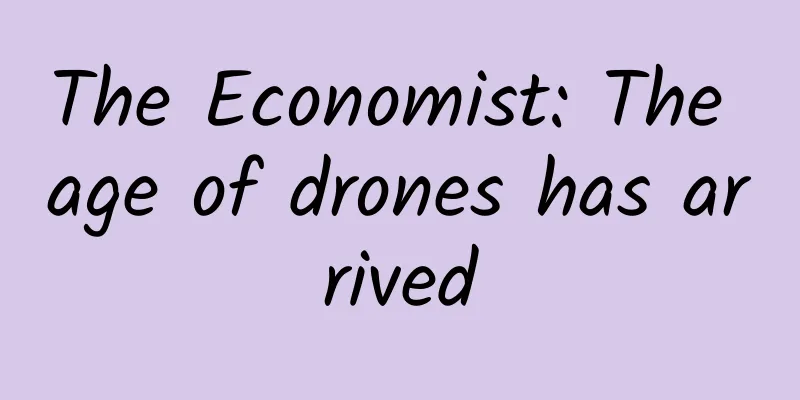The Economist: The age of drones has arrived

|
The Economist website reported that the scale and scope of the use of small civilian drones has attracted the attention of many people. In 2010, the Federal Aviation Administration predicted that the number of drones in the United States could reach 15,000 by 2020. But now, the monthly sales of drones have far exceeded this number. Drones are not just a craze in the United States. Some analysts believe that more than 1 million drones will be produced and sold worldwide this year. They see the current major advances in drones as being very similar to the rapid development of personal computers in the 1980s, when Apple and IBM introduced the Macintosh and PS/2, respectively, and these machines went from hobbyist toys to necessities for businesses and individuals. That may sound a bit exaggerated. After all, it's hard to find a business that hasn't benefited from personal computers, but many businesses probably won't benefit from drones at all, at least not directly. Yet the practical applications of these small remote-controlled aircraft are expanding rapidly. After years of delays, the Federal Aviation Administration finally approved more than 1,000 commercial drone flight licenses in August. Drone applications include agriculture (farmers can use drones to monitor crop growth, pests, etc.), land surveys, film shooting, security and delivery services (Swiss Post is experimenting with using drones to deliver packages weighing up to 1 kilogram, and Amazon , Google ( Weibo ) and UPS are also testing similar ideas). Drone Club Businesses are not the only ones who see the potential of drones. Academics also see many uses for them waiting to be discovered. Since drones are cheap to manufacture, geologists who cannot afford traditional aerial surveys can use them to track erosion, trace changes in river headwaters, and explore glaciers. Archaeologists and historians can use software to use drones equipped with common digital cameras to capture accurate 3D models of buildings or landscapes, including helping them map ancient sites and earthworks. Drones can also reach places that manned spacecraft cannot reach, including the craters of active volcanoes and the interiors of caves. Drones at the Woods Hole Oceanographic Institution in Massachusetts, USA, have even been used to obtain breath samples from whales for DNA analysis. As expected, drones are particularly useful when studying birds. For example, standard commercially available drones can be modified to count bird nests in the canopy of a forest. In addition, public services are increasingly using drones. To count bird nests, for example, drones don’t alert wildlife. In Ottawa, officials are taking the opposite approach, using a “goosebuster” drone equipped with multiple speakers to simulate the calls of geese’s predators hunting. This solved a problem in the city park on Petrie Island, where there were hundreds of geese and their droppings were causing problems. In Michigan, police are considering using drones to map crime scenes so that closed roads can be opened more quickly. Drones can also save lives while ensuring parks are clean and avoiding traffic jams. For example, in June, firefighter Frank Roma rescued two boys from a river in Maine with the help of a drone. At the time, the children were trapped on rocks in the turbulent river. Roma used a drone to carry a rope and delivered life jackets. The children put on life jackets before an inflatable boat rescued them. Other uses of drones have been questioned, such as their use to smuggle drugs and mobile phones into prisons. Similar reports have been made in the United States, Australia, Brazil, the United Kingdom, and Canada. In the United Kingdom, police have also found criminals using drones to scout homes for theft. In January, a drone crashed on the White House lawn, highlighting its threat, which can be used by terrorists. In June, anonymous graffiti artist KATSU released a video using a drone to destroy one of New York's most famous billboards using an aerosol spray. How can all this activity be regulated? As the Federal Aviation Administration puts it bluntly, there is no adequate regulation yet. Drones pose safety and privacy concerns, and their noise can be annoying. But these new machines are so cheap, so useful, and so full of unpredictable potential that the best way to regulate them may be to put the thousands of drone operators under the spotlight. Pioneers in the drone space include the AR and Phantom. The AR is a drone from French company Parrot that became a big hit in 2010. It is a very easy-to-fly quadcopter drone that can send video to a smartphone. In 2013, Chinese drone manufacturer DJI released the Phantom, giving regular users a taste of professional-grade aerial photography. The latest version of the Phantom costs less than $2,000 and can shoot 20 minutes of video. How long the two companies will dominate the drone industry is unclear, but Andrew Amato of U.S. consultancy Dronelife.com said the Phantom's limited flight time was its Achilles' heel. Drones that can fly longer (up to an hour) could change the market, while sense-and-avoid technology, which allows drones to avoid obstacles, is something researchers are working on. The rapid rise of drones For drones, sense-and-avoid technology could ensure that drones can fly safely in public airspace without the need for close human monitoring. But this goal cannot be achieved without additional sensors, such as radar. Using the video cameras on the drones themselves to identify objects in real time requires a huge amount of computing power. However, some companies are trying to solve this problem, including Bio Inspired Technologies in Idaho, USA. The company is trying to solve this problem using hard-wired neural networks. The company's engineers believe that their technology can be trained to recognize and avoid aviation obstacles. In addition, by understanding how objects are captured by drone cameras, traditional computers (high-end) can be programmed and algorithms pre-designed to identify and avoid threats. Tel Aviv-based Percepto is using this approach, code-named "Intelligent Vision." Percepto's system can also set the camera's frame by calculating lighting angles and other methods. Whichever approach wins out (training and learning or pre-programmed recognition software), drones that can understand their environment are more useful in some way. For example, drones can identify their operators and where they are stationed when necessary. Drones can be released to explore sinkholes when roads are frozen and unnavigable. They can also cruise through forests to detect fires in advance, or search for missing travelers, etc. Extended flight time will make all of these hypothetical applications more attractive, and many companies are working on them. The most common way is to turn an unmanned helicopter into an unmanned aircraft in mid-air. The former relies on power-consuming blades to stay in the air, while the latter uses fixed wings to fly more efficiently. The SkyProwler launched by Krossblade in Arizona, USA, looks more like an airplane, but it has four propellers that can be extended outside the body to help it take off and land vertically. The company's boss, Dan Lubrich, claims that their drones are more efficient whether hovering or flying forward, and the conversion mechanism only adds 10% to the drone's weight. SkyProwler can cruise at speeds of up to 100 kilometers per hour and fly for up to 40 minutes. It can hover to shoot video or deliver a package, then return. The drone is expected to go on sale in December. VTOL Technologies, a company supported by the University of Reading in the UK, is developing a drone called Flying Wing with a wingspan of up to 120 cm. Flying Wing has four ducted fans that propel it into horizontal flight, but their attitude can be adjusted so that they can directly provide lift. Upshot is a device that can change the angle of the wind to provide greater lift, allowing the drone to hover in the air like a seagull or other bird, consuming almost no energy. VTOL Technologies estimates that Flying Wing can continue this flight mode for 1 hour, or maintain horizontal flight for more than 2 hours. The days of the duopoly of Parrot and DJI in the drone market appear to be numbered. Yamato compares it to IBM, which once dominated the personal computer market but whose dominance has been shaken by the rapid influx of competitors. Of course, this doesn't destabilize Apple's core business, which has a loyal and niche user base. But it also means that small computers are becoming an everyday commodity. Like drones in the wind, the future of this market will have many twists and turns, but all signs indicate that the sky will soon be filled with the buzz of drones. As a winner of Toutiao's Qingyun Plan and Baijiahao's Bai+ Plan, the 2019 Baidu Digital Author of the Year, the Baijiahao's Most Popular Author in the Technology Field, the 2019 Sogou Technology and Culture Author, and the 2021 Baijiahao Quarterly Influential Creator, he has won many awards, including the 2013 Sohu Best Industry Media Person, the 2015 China New Media Entrepreneurship Competition Beijing Third Place, the 2015 Guangmang Experience Award, the 2015 China New Media Entrepreneurship Competition Finals Third Place, and the 2018 Baidu Dynamic Annual Powerful Celebrity. |
>>: United Nations Environment Programme: Carbon Gap Report 2021
Recommend
Waymo partners with car rental giant Avis to provide self-driving cars as a service
According to Reuters, Alphabet's self-driving...
How to accurately estimate user intent when placing Baidu information flow ads in the home improvement industry?
The home improvement industry is a typical large ...
Do you need to remove wisdom teeth? Not necessarily! | Expo Daily
Do you need to remove wisdom teeth? Not necessari...
Finally cool? Autumn heat: I don't exist? Please beware of this wave of "residual heat" →
The dog days are over, and it seems that there is...
As high temperatures approach, be alert to these 8 summer diseases!
On June 15, the Central Meteorological Observator...
“Vegetables hit by frost are especially sweet.” What does winter do to plants?
As winter is approaching, people have to worry ab...
Platinum: Behind my good looks, I am also quite capable!
Platinum, element number 78 in the periodic table...
Chinese Valentine's Day copywriting, I finally waited for you!
Please note that the dog-torturing Chinese Valent...
Science in Poetry | From firecrackers to guns and cannons, how did gunpowder change the evolution of human history?
New Year's Day (Song Dynasty) Wang Anshi The ...
This plant can catch insects in just 0.01 seconds
What is the biggest difference between plants and...
Don't sit on a shared massage chair, it's horrible!!!
Recently, the topic of “shared massage chairs” ha...
How to promote App with low cost and very good results on AppStrore hot search - Sina Weibo
Starting from December last year, you can often s...
Dry eyes...how did it become a terminal illness?
How many times have you watched "Kuaisan&quo...
How to apply for WeChat Small Store? The application process is as follows
WeChat officially announced on August 20 that WeC...
What does the finished product of the birthday wishes for African children include? Are there any photos to give away?
In addition to providing customers with the conte...









